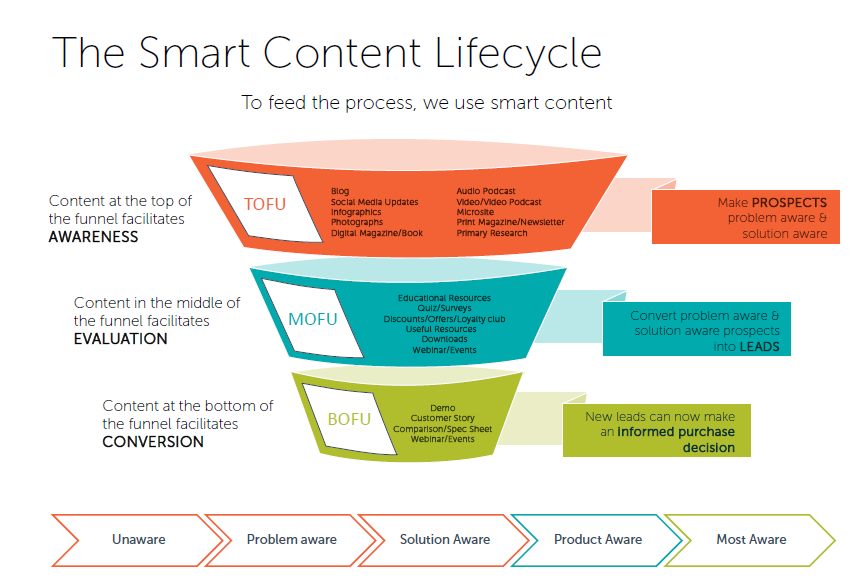The smart content marketing funnel
Is content marketing just another in a long line of marketing buzz words? Well, here at The Marketing Eye, we don’t think so.
According to the Content Marketing Institute: “Content marketing is a strategic marketing approach focused on creating and distributing valuable, relevant and consistent content to attract and retain a clearly-defined audience — and, ultimately, to drive profitable customer action.”
Instead of focusing purely on your products and services, the idea is now to provide useful and relevant content to your prospects at all stages of the buying lifecycle.
Why is it important?
There can be no doubt that we are now in the era of self-serve information. Access to information is available 24/7 and reduces risk, saves us time and saves us money. According to Jay Baer, author of Youtility: “In 2011, the Corporate Executive Board in the US surveyed 1900 B2B customers to uncover insights about purchasing behaviour and found that customers will only contact a sales rep after independently completing 60% of the purchasing decision process.”
This confirms that potential prospects are carrying out their own independent evaluation before making any calls or sending emails and thus identifying themselves to you. Furthermore, Google supports this theory by citing that 84% of shoppers say they use devices to learn more about a product of service that they are thinking about trying or buying .
The reality is that we are witnessing a shift from the persuasiveness of pure promotion to the importance of providing information.
The content lifecycle

The top of the funnel (awareness)
Let’s consider content and its role in terms of a funnel lifecycle.
At the top of the funnel the aim is to facilitate awareness and make prospects problem and solution aware. Prospects will be completely unaware of your solution and often unaware of their problem or opportunity. Content at this stage, therefore, needs to be FREELY available and must aim to educate, entertain or inspire. Blog posts, social media updates and infographics are all good examples.
Unfortunately, a lot of organisations begin and end their marketing efforts here.
The middle of the funnel (evaluation)
If you have an existing business, your most lucrative content pieces will be in the middle and bottom of the funnel. Here lie your quick wins.
The challenge now is to move prospects from awareness to evaluation. The goal is to convert these “problem aware” and “solution aware” prospects into LEADS.
At this stage, again, use FREE content to incentivise prospects to submit their contact information and opt-in to receive future marketing communications.
The content you produce needs to act as a lead magnet. Good examples include case studies, white papers, surveys, webinars and events.
The bottom of the funnel (conversion)
The ultimate goal is to convert leads into paying customers, so what types of content does your lead need to make an informed purchase decision?
In theory, they’ve downloaded a blog, they’ve read your white paper… You now need to provide them with case studies, webinars, events, free trials etc. and demonstrate how your product or service can deal with your lead’s circumstances. You need to help them to decide between you and your competitors and move them to an informed purchase decision.
Underpinning all of this are your buyer personas. These are your ideal customers. You need to identify who they are and where they are, and then think about their needs and wants – now and in the future. This, is turn, will help you create the necessary content pieces for each audience. Remember, you need content that will convert prospects at all stages of the funnel.
Good UX performance
To create a good user experience (UX) with your content, you also need to consider the next logical step for each piece of content that you have. This, in turn, will create a clearer path to conversion. From blog content, for example, prospects should have the option to opt in with their email address to get more information about a topic.
Content marketing plan
With a good grasp of the strategy, you are now able to create your content marketing plan. The aim of the plan is to align your content marketing with your business objectives; for example to generate leads and sales. Key elements should include:
- Funnel – is this piece of content addressing a need at the top, middle or bottom of the funnel?
- Buyer personas – which buyer persona(s) will this piece of content target?
- Vehicle – will this be a text, image, video or audio piece?
- Channel – where will this content be published? For example, on your blog, website or as part of your social media updates.
CTA – what call to action (CTA) will be used?
Finally, don’t forget to measure the impact of your content marketing. This includes the obvious consumption metrics, such as the number of downloads and how many people are reading your blog, to sharing metrics such as tweets, shares and reviews.
However, don’t just stop there.
A marketing automation system will be able to provide you with a timeline representing the life of your lead. You can ascertain what content is being consumed and if your prospect wants to learn more. It will also identify which customers originated from which piece of content. “Page Value” in Google Analytics also allows you to determine the impact of individual pages on lead generation and sales.
So, there you have it, the backbone of your content marketing strategy – effective, logical and measurable.
If you need help with anything mentioned in this blog post – give us a call or contact us by email here.
Related Reading

Blog: Mastering Email Engagement with Lead Gen & CRM
by Darren Coleshill, 5 minute read

Blog: How to Build a Marketing Funnel That Converts (And What to Avoid)
by Darren Coleshill, 6 minute read